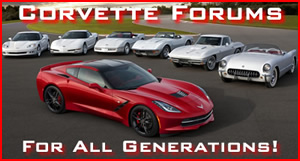Ruthless Pursuit of Power: The Mystique of the C6 Corvette LS7 Engine - Page 7 of 26
Ruthless Pursuit of Power: Lucky Seven Edition: The Mystique of the 7-Liter, 7000-RPM, LS7 - Page 7 of 26
 |
 |
by Hib Halverson
© May 2013— Updated: November 2014
No use without permission, All Rights Reserved
Cutting-Edge Piston
In a departure from what most people, including some veteran mechanical engineers, would expect, the LS7 engine does not use a forged aluminum piston. It uses a cast, eutectic aluminum piston, but that's greatly simplifying the issue as there's quite a story to the LS7 piston. "They started out with forged on the six-four." John Rydzewski told the CAC. "When they picked a (piston) supplier for the seven-liter, it was Mahle which came back and said, 'We can do this in a cast piston. We've got the knowledge and it will work.' The decision was to proceed with a cast piston. It met all the requirements--met the specifications and it was less expensive."
In February of 2012, we visited Katech to learn more about its role in helping GM bring the LS7 to market and cast piston was an issue we covered. "One of the big challenges with a cast piston was durability at 7000 RPM," Katech's CEO, Fritz Kayl, told us. "We did stuff later in the program on that. We met the power targets pretty easy but the durability side was more of a problem. The big challenges were piston speed and how to reduce parasitic losses.
"With a four-inch stroke, you have tremendous piston speed. I'll give credit to GM--they set that (cast piston) as a challenge and they were not going to give-up on it. Certainly we didn't have that technology here. Everything we do in racing is forged pistons, but with the LS7, forged pistons were off the table.
"At that time, piston speed for racing (C5-R forged piston) was about 4500 feet-per-minute but 7100-RPM for a Corvette LS7 is 4700 feet-per-minute. (LS2 and LS3 cast piston speeds max'ed at 4000-fpm.) And of course, bearing loads and everything else goes up with (the square of) piston speed. That's why the concern. They had some problems with pistons in the early going but they got it solved. As it turned-out, they (GM and Mahle) were right. Those pistons are durable.
So, how did Mahle pull off an advancement some thought impossible? By combining a special aluminum alloy with a new casting method, more robust heat treating and new developments in piston structure.
The LS7 piston is cast from a eutectic aluminum/silicon alloy having small amounts of copper and nickel. This alloy, "Mahle 142," was first used for pistons in the LS6 engine of 2001. "M142" offers increased strength and less expansion at high temperature providing better control of piston-to-bore clearance, both at the skirt and the ring lands. That improved dimensional stability reduces piston noise, improves oil control and enhances durability.
In an interview, Aaron Dick, the Application Manager assigned to the LS7 piston development at Mahle, told the CAC, "We did (a cast piston) primarily for weight-reduction. A requirement was very lightweight reciprocating masses. Taking that challenge, we looked at a new, patented casting process we had. We were able to cast the piston lighter than we could make a forging."
Mahle developed the "Ecoform" casting process in the early-'00s as a mass reduction strategy and LS7 was one of its first applications. This casting technology creates recesses, or cavities, in the ring belt which could not exist in a forging. The resulting high-strength, reduced-mass, cast piston was cutting edge technology for high-volume, production engines in the mid-'00s.
The heat treat specification for the LS7 piston is, also, a departure from the norm and intended to improve strength. "The vast majority of gasoline pistons have a T5 heat treat where the LS7 has a T7 heat treatment," Dick continued. "That increases the strength and the hardness of the piston and that adds strength at the pin bosses--the lower temperature parts of the piston. At high temperatures, the heat treatment is not as critical. In the piston crown, for example, it's not helping as much, but in the lower end of the piston, the T7 heat treat improves the properties of the material. This helps when you have 'inertia loads'--high speed but no load. For example: if you downshifted going into a corner, when the engine revs up, (inertia loads) are trying to rip the piston pin out of the piston."
The LS7 piston has "asymmetric" skirts with the major thrust face being wider than the minor face, a configuration responsible for another slight mass decrease. The skirts are coated with "Grafal", Mahle's proprietary, polymer coating which reduces friction, increases scuffing resistance and allows less piston-to-bore clearance leading to less engine noise.
 |
 |





